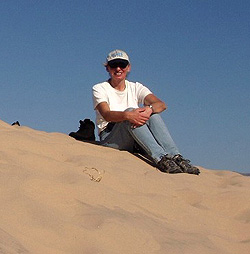Feature
Bringing Space Down to Earth
06.16.05
| Who Are NASA's Earth Explorers? The elementary school student questioning if El Niño occurs anywhere besides the Pacific Ocean. The researcher investigating connections between Arctic ozone depletion and global climate change. The citizen scientist interested in how changing land cover and use affects animal migration patterns. And the businessperson projecting future needs for harvest, delivery and storage of crops. All of these people are Earth Explorers -- they are all connected by their curiosity about Earth system processes. This monthly series will introduce you to NASA Earth Explorers, young and old, with a variety of backgrounds and interests. Nominate an Earth Explorer! Tell us about the Earth Explorers you know. We're looking for students, teachers, scientists and others who are working with NASA Earth science data and imagery to better understand our home planet. Send your nominations to Dan Stillman: dan_stillman@strategies.org. |

|
Image to right: Diane Evans sits atop a sand dune in the Mojave Desert east of Los Angeles. Credit: NASA
Therein lies the challenge faced by Diane Evans, director for Earth Science and Technology at NASA's Jet Propulsion Laboratory. Her job, as she describes it, is "to make sure all the amazing breakthroughs made by the engineers, technologists and scientists are also applied to NASA's goal to improve life here on Earth."
Earth Explorers talked with Evans about what she does, her background in geology, and what advice she has for young women interested in science. Here's what she had to say.
Earth Explorers (EE): In a practical sense, what does it mean to apply cutting-edge space technology to improve life on Earth?
Evans: This means going beyond "gee whiz" and answering "so what?" For example, radar technology developed to map Venus is also used to assess earthquake risk. And specialized telescopes used to study star formation can also reveal information about Earth's ozone hole.
EE: What are some specific research goals that JPL scientists are currently working on?
Evans: Right now we're working on ways to measure one molecule of carbon dioxide in 1,000,000 molecules of air, and changes in sea surface salinity equivalent to adding one-sixth of a teaspoon of salt to one gallon of water. Climate scientists need these incredibly challenging measurements to improve their models of global warming.
EE: Geology was the focus of your academic career and the early part of your professional life. What sparked this interest?
Evans: I became interested in geology when I was working at Yellowstone National Park the summer after my freshman year in college. I was amazed by the bubbling mud pots (turbulent pools of hot, muddy water) and wanted to learn more about what caused them. I started taking geology courses when I returned to school in the fall and found them to be the most interesting classes I'd ever had.
EE: Has it been hard to transition from a geology-focused background to your current position, which involves topics ranging from oceanography to atmospheric composition?
Evans: Although I'm not able to get involved in detail with the science analysis, having a science background helps me to understand in general what a research team is trying to accomplish. One of the biggest challenges we face is to translate science goals into engineering and technology requirements, and that is largely independent of scientific discipline.
EE: While in graduate school at the University of Washington in the late '70s and early '80s, you studied the surface geology of Mars. Did you ever envision then that you would someday be working at NASA at a time when there would be talk of a manned mission to Mars?
Evans: One of my jobs in the remote sensing lab at UW was to weigh lunar samples. At that time we were definitely thinking about the day when we'd have samples from Mars to study, and there was talk about the challenge of sending humans even then.
EE: What is the most interesting place you have visited during your career at NASA?
Evans: Working in northwest China in the early 1990s was fascinating. We were in small towns -- oases in the desert -- where cars were rare and people drove donkey carts. There were very few westerners in that part of China at the time. It was extremely enjoyable to interact with the local people, and the geology was amazing.
EE: What have you learned from working with scientists around the world?
Evans: International cooperation is integral to scientific research. Progress is made the most rapidly by having people with different perspectives involved. It was particularly interesting to be involved in the joint U.S.-German-Italian Space Radar Laboratory (a suite of instruments launched to study Earth's environment from space), since we needed consensus between the three parties to have a successful mission. I learned a lot about what people from other countries value and how they make decisions.
EE: Do you have any advice for young women interested in pursuing science careers?
Evans: A science career can be rewarding and in general allows for a fair amount of independence. It may actually be a better career choice than most for women. Scientists tend to be open-minded, and people are respected based on their work rather than who they are. As with any career choice, the key is to follow your passion. If you find something that you enjoy, the rest is easy.
See previous Earth Explorers articles:
+ View site
Related Resources
Exploring the Environment: Yellowstone Fires
+ View site
JASON Expedition: Mysteries of Earth and Mars
+ View site